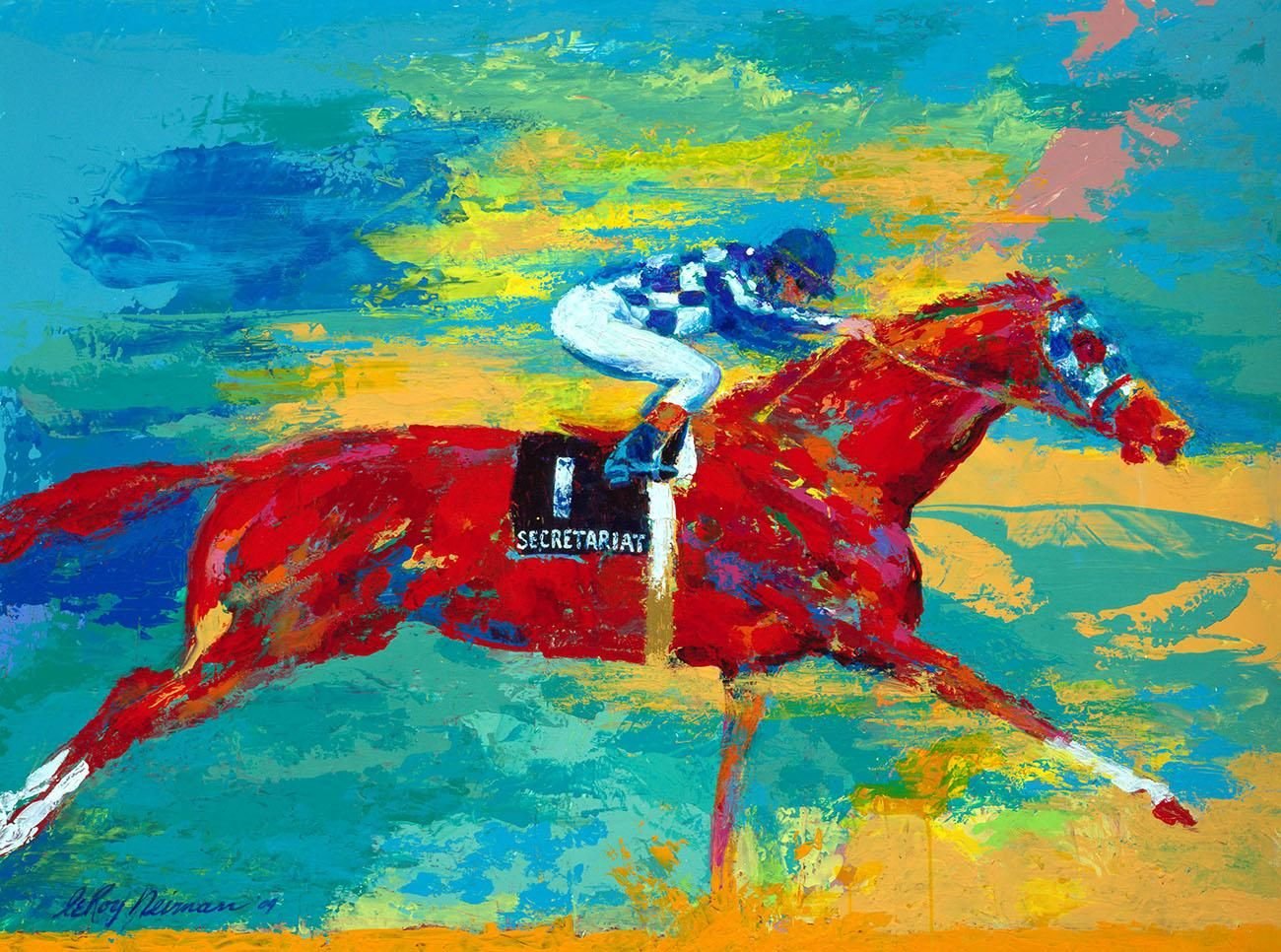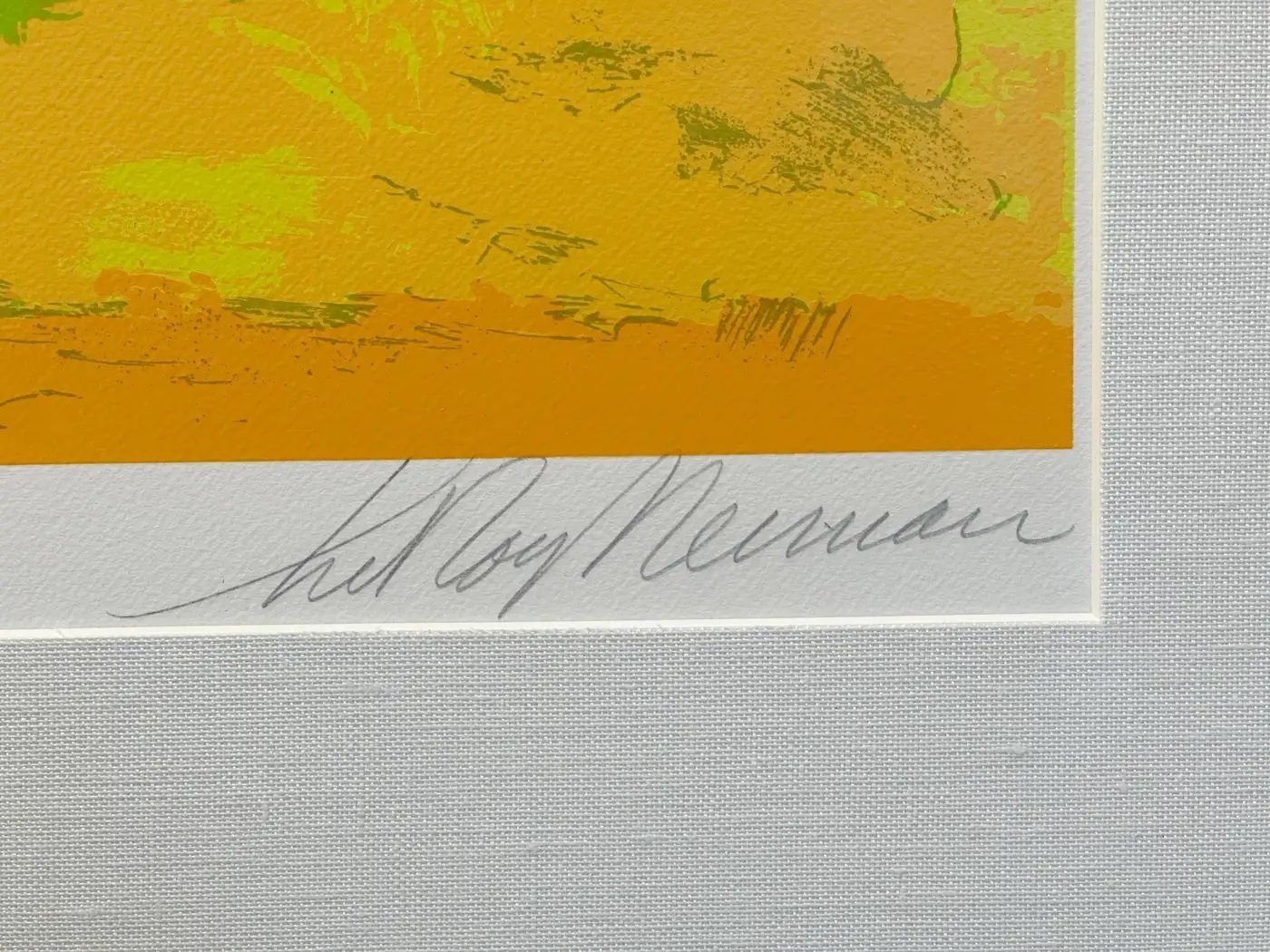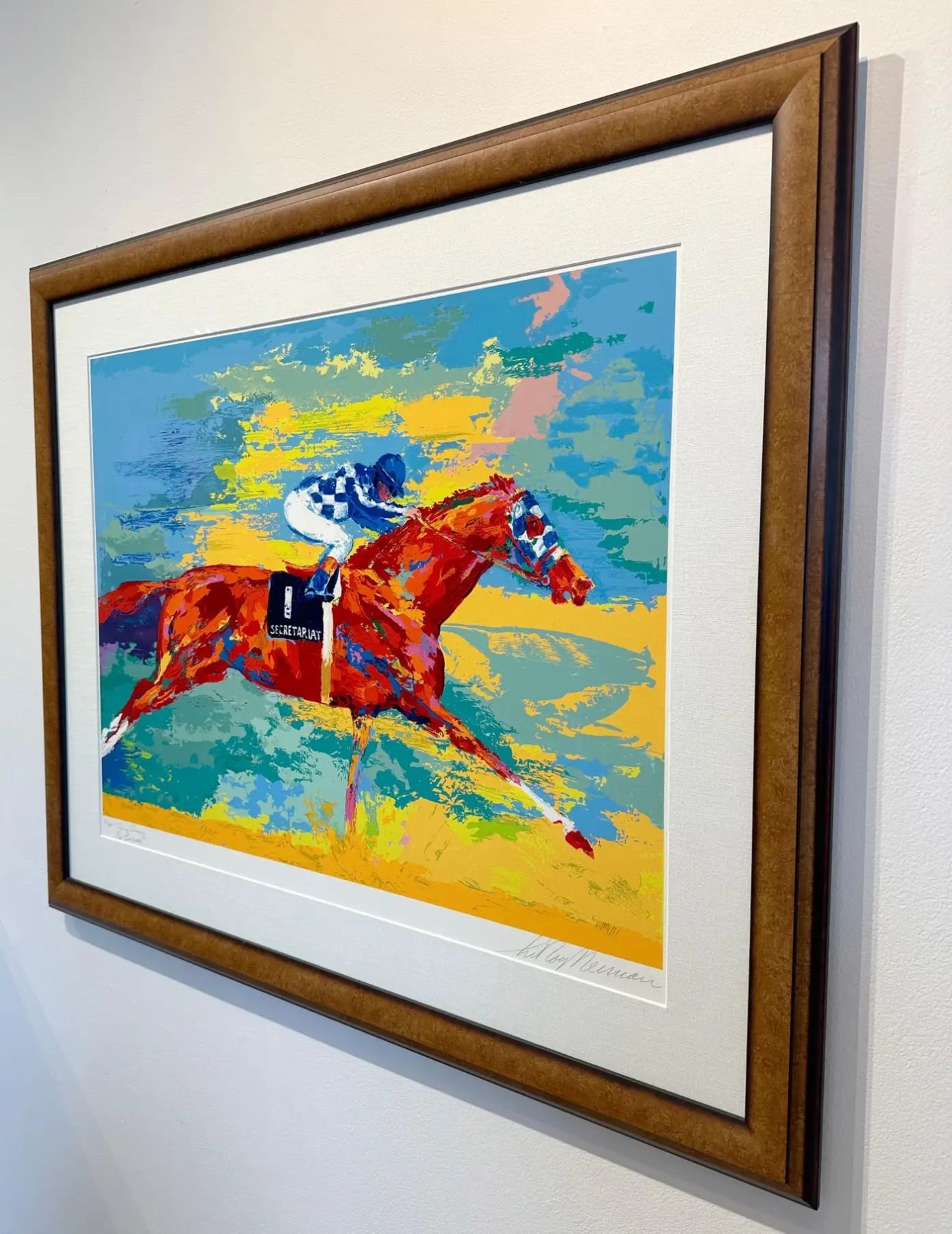
LeRoy Neiman
The Great Secretariat
Serigraph on Paper
by LeRoy Neiman
Signed by Secretariat owner Penny Chenery and jockey Ron Turcott.

Detail of LeRoy Neiman's signature on The Great Secretariat

The Great Secretariat by LeRoy Neiman, framed.

Detail of Secretariat owner, Penny Chenery, and jockey, Ron Turcotte's, signature on The Great Secretariat by artist LeRoy Neiman. Edition 73 of 250.

The Great Secretariat by LeRoy Neiman, framed, side view
About this Piece
The featured serigraph portrays Secretariat in full stride, nearly airborne, characteristically stretching toward the finish line. The red-hued horse and his jockey (Ron Turcotte) wear their unique blue and white check silks, representing the legendary Meadow Stable. Vibrant in color and meticulous in detail, Neiman also captures the white wisps in the cannon and fetlock. LeRoy Neiman previously released Secretariat (Big Red) in 1973 and Secretariat II in 1990. It is a testament to the horse’s greatness that Neiman has released prints of him three times. Among humans, only Muhammad Ali and Frank Sinatra have been so honored. Truly exclusive company.
Neiman’s paintings and prints are as prized for their beauty as their investment potential. His earlier Secretariat serigraphs listed above have long since sold-out and currently can command upwards of $8000 on the secondary market. The serigraph was produced in a limited edition of 250 numbered impressions measuring 25 ½” x 34" and signed by the artist. owner Penny Chenery's and Ron Turcotte's signature as well. "The Great Secretariat" was commissioned in part to benefit the Secretariat Foundation, which is devoted to the fields of research, rehabilitation, and retirement for Thoroughbred horses... a great painting for a great cause! Anyone who appreciates fine art will treasure this portrait of a great champion for generations to come.
The History
Printing, especially serigraphy, was LeRoy’s most prolific medium. During his busiest time period, Neiman printed an average of six serigraphs per year. The works were printed in limited edition runs by hand in New York City at several print shops through the years, namely at BrandX. Serigraphs or silkscreens are created one color at a time and sometimes have up to 60 layers of color per print. The serigraphs are recognizable by the artist’s signature primary color palette and expressionist style. Neiman also used printing techniques like monoprinting, etching, lithography.
Through his global travels, LeRoy encountered and became fascinated with the majestic, exotic animal kingdom. His most visited creatures, including big cats, elephants, and horses, reflect his joie de vivre and ferocious confidence. Many of these pieces were inspired by trips through the sweeping plains of Africa, where Neiman determined to record the safari as art.
LeRoy Draws Swoboda, 1969. LeRoy Neiman and Janet Byrne Neiman Foundation Archives
About Leroy Neiman
LeRoy Neiman was born in Saint Paul, Minnesota, on June 8, 1921, to Lydia Serline and Charles Runquist. When LeRoy was five years old, his father left, abandoning the family. Taking the last name of Lydia’s second husband, John Neiman, LeRoy grew up in Saint Paul’s hardscrabble, blue-collar neighborhood of Frog Town. He showed an early knack for drawing—and selling. Creating posters for local merchants to advertise their store sales, LeRoy peddled his work for a nickel apiece. He picked up extra change by drawing ink tattoos on the forearms of his schoolmates.
Leaving Saint Paul for the U.S. Army, Neiman worked as an army cook, painted sets for Red Cross shows, and created bawdy murals on the walls of World War II mess halls. For a period, he went AWOL falling in love with an older woman and living with her in Eupen, Belgium. Eventually, he left the Army with an honorable discharge.
Thanks to the G.I. Bill, Neiman pulled together enough money to study at the Saint Paul School of Art and the School of The Art Institute of Chicago (SAIC). At SAIC, in a class of 1950 that was rife with talent, Neiman studied alongside Robert Clark (who later changed his last name to Indiana) and Leon Golub.
Neiman portrayed life as a series of epic moments, alive with palpable drama, and enacted on a world stage by the greatest athletes and entertainers. He did pre-fight sketches for the first Muhammed Ali-Joe Frazier bout for The New York Times Magazine. But Neiman owed his increasing worldwide renown to television. He not only made art available to the masses via TV; he helped to demystify art for everyone who saw his work. Named the official artist of the Olympiad in 1972, he held that role through five Olympics. His al fresco paintings of the Olympic competitions made his art visible to millions of people. And his TV appearances—donning his handlebar mustache and his waving ever-present Cuban cigar—made Neiman a media showman and one of the world’s most famous living artists.
“I created LeRoy Neiman. Nobody else told me how to do it. Well, I’m a believer in the theory that the artist is as important as his work.”
In 1986, Neiman and his wife, Janet Byrne Neiman, created the LeRoy Neiman Foundation to fund programs supporting and advancing arts education. Through their foundation, they created the LeRoy Neiman Center for Print Studies at Columbia University’s School of the Arts, the LeRoy Neiman Center for Study of American Culture and Society at UCLA, and a UCLA LeRoy Neiman scholarship. Just as Neiman’s art was for all people—a global audience that stretched far beyond the traditional art elite—Neiman wanted his philanthropy to reach the disadvantaged. He began partnering with various arts education organizations to support young artists. In 2011, one year before he died, UCLA opened the LeRoy Neiman Student Center—an appropriate tribute for an artist who educated the world. By the end of his life, Neiman had painted on five continents and chronicled global culture via thousands of paintings, drawings, and prints. His legacy endures not only in museums and galleries and auction catalogues, but also in the education programs he created to inspire young artists and the community centers he funded to give children safe places to play and create.
—Written by the LeRoy Neiman and Janet Byrne Neiman Foundation





